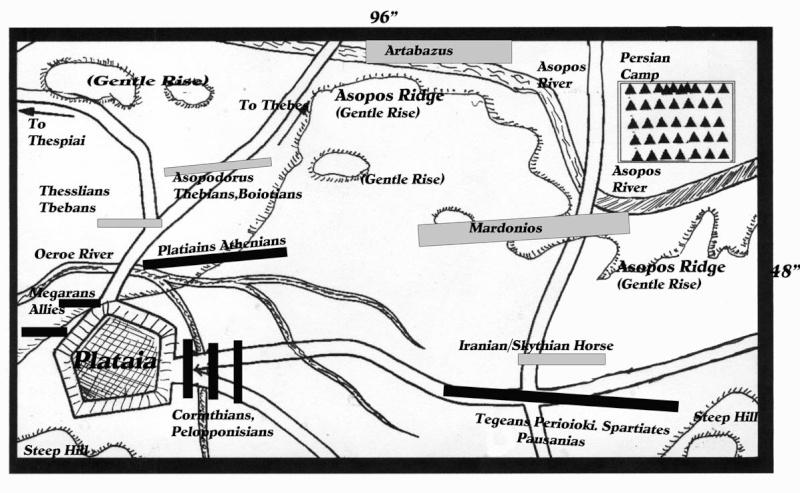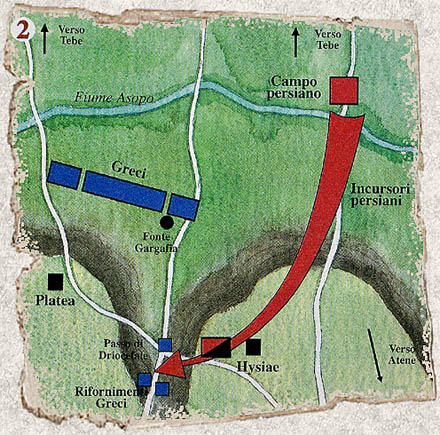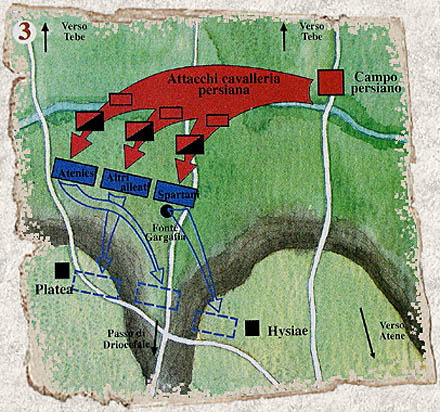
SCENARIO per regolamento ARMATI 2nd edition
The Battle of Plataia, Central Greece – 4th Day of Boedromion, 479 BC.
The Greeks regain their Freedom!”
The Forces.
Remainder of the Persian Army left by King of Kings Xerxes, under the command of Mardonios, Satrap of Greece.
Mardonios’ Force. Mardonios +1, +2 rally#
CR: H:5; L:3 BP -5 Init: 5
-> 1 Ft. 8 [1]1 +2 Spears/Bow BP-4 (Immortals)
-> 9 Ft. 7 [1]1 +2 Spears/Bow BP-3 (Iranian/Medes)
-> 3 HC 4 [0]0 +1 Spears/Bow BP-3 (Iranians)*
-> 4 HA 2[0]0 +1 Bow (Skythians)
Artabazas Force Artabazas +1 +1
CR: H:3; L:1 BP -3 Init: 5
-> 3 Ft. 7 [1]1 +2 Spears/Bow BP-3 (Medes)
-> 2 Ft. 6 [1]1 +2 Spears/Bow BP-3 (Saca)
4 Ft. 5 [1]1 +1 Spears BP-3 (Bactrians)
3 Ft. 5 [1]1 0 Bow BP-3 (Indians)
-> 1 HC 4[0]0 +1 Spears/Bow BP-3 (Medes)*
2 SK 2[1]1 +2 Javelins BP-1 (Bactrians)
Asopodorus’ Medizing Hellenes Asopodorus +1+1
CR: H:3; L:2 BP -3 Init: 4
-> 2 HC 4[0]0 +1 Spears BP-3 (Thebans)
-> 2 LC 2[0]0 +1 Javelin BP-2 (Thessalians)
-> 2 Ph 7[1]1 +2 Spears BP-4 (Thebans)
-> 3 Ph 6[1]1 +2 Spears BP-4 (Boiotian League)
2 LI 4[1]2 +1 Javelins BP-2 (League Peltasts)
# Mardonios must be attached to the rallying unit to give this bonus.
* Before the battle starts, any Persian HC cavalry may be converted to a 2 [1]0 LC unit with bow OR javelin.
==============================================
Hellenic League Strategos Pausanias
Athenians: Aristides +1 +1
CR: H:4; L:2 BP -4 Init:4
-> 6 Ph 7[1]1 +2 Spears BP-4 (Athenian Levy)
-> 1 LHI 4[1]2 +1 Spears/Bow BP-4 (Maritime Archers)
-> 1 Ph 7[1]1 +2 Spears BP-4 (Plataian Levy)
2 SK 2[1]1 +2 Javelins BP-1 (Armor bearers)
Megarans, Allies Theogiton +1 +1 ##
CR: H:2; L:2 BP -2 Init:4
-> 2 Ph 7[1]1 +2 Spears BP-4 (Megarian Levy)
-> 3 Ph 7[1]1 +2 Spears BP-4 (Assorted Polioi)
2 SK 2[1]1 +2 Javelins BP-1 (Armor bearers)
Peloponnesians Kleocritos ###
CR: H:4; L:2 BP -4 Init:4
-> 3 Ph 7[1]1 +2 Spears BP-4 (Corinthian Levy)
-> 4 Ph 7[1]1 +2 Spears BP-4 (Peloponnesian Levy)
2 SK 2[1]1 +2 Javelins BP-1 (Armor bearers)
Lakedaemonians: Pausanias +1 +1
CR: H:4; L:2 BP -5 Init:4
-> 5 Ph* 8[1]1 +2 Spears BP-4 (Spartiates)
-> 5 Ph 7[1]1 +2 Spears BP-4 (Perioikoi)
-> 1 Ph 7[1]1 +2 Spears BP-4 (Tegeaian Levy)
4 SK 2[1]1 +2 Javelins BP-1 (Helots)
* May wheel and move like COH.
Victory.
Persians must break the Lakedaemonians, or any TWO other forces, before turn 20.
Greeks win by avoiding the Persian conditions.
Terrain:
The arguments about this battle’s terrain are legion. I have followed Pritchett as his arguments make the most sense. I have ignored Hanson, since his translation of Herod.
and mine differs in major points. I was fortunate to walk the field in 1976, and took numerous pictures, before my beloved Lecia was confiscated near Sparta.
In Armati terms the Asopos ridge is a gentle rise, with some parts higher the others, (shown) but for the most part slopes gently up to the foot of Mount Kithiron, which is depicted as a steep hill. Plataia’s gates are closed and divisions must move around it. The Oeroe River is fordable at 2” cost, but if meleed in it, units are undressed. The River Asopos is fordable ONLY at the non crossed hatched areas. It takes ½ move to cross.
Deployment:
The Athenian line and Boiotian cavalry start 5” apart.
The Megarians and Allies must be in two Heavy divisions.
The Peloponnesians must be in three Heavy divisions.
The Lakedaemonian line and the Persian cavalry starts 5” apart.
Main forward battle lines must start at least 16” apart. (Except Artabazus who starts fording the Asopos River.)
The battle really starts with the Greek battleline pulling back to area around Plataia, and Hysiae during dark since they lost their water supply at Gargaphia. The center got lost and retreated to the walls of Plataia instead of the east where the fingers of the River Oeroe would take care of their supply. The Athenians on the left were stuck, the center took the Athenian’s road, and they had to wait for it to clear, and apparently the Lakedaemonians were having command problems, so they hadn’t pulled out yet. This meant only the center retreated and left a huge gap in the Greek line. By daylight, both wings were on the move, but raising dust plumes that the Persians quickly saw.
Burns and Green in their books has the Spartan commander pulling some sort of feigned flight in the morning to tempt Mardonios to attack him. Herodotos disagrees with them, and I see no reason to doubt him. The Greeks had never operated together before in a major campaign and could easily screw up a retreat, it was dark, nobody had radios, and communications between the wings were by couriers who often got lost themselves.
The point is that when dawn broke, the Greek battleline had apparently disintegrated; the Athenians could not be seen, since they were down behind high point of the ridge, the center was milling around the walls of Plataia, and the Lakedaemonians were struggling back to the foothills of Kithiron, apparently running.
Mardonios, who Herod. claimed knew the art of war, (he was one of Xerxes second in army command and his trusted advisor) jumped at this chance. Calling the Spartans cowards, he sent the cavalry his wing out to harass the retreat, and with his Iranians of his wing headed up the slope of the Asopos ridge.
It is easy to claim he was fooled, but how? He was following standard biblical tactics, fix the enemy so he cannot withdraw, then bring up the archer pairs to shoot the enemy down. What he did not realize was like at the Hot Gates, this enemy was dangerous when brought to bay.
The map shows the exact moment as Mardonios has planned it. The Persian horse has halted the Lakedaemonian advance and forced them to form Phalanx. On the other flank the Thessalian horse has done the same with the Athenians, and the Boiotian League is closing to fight.
The battle now begins.
Numbers.
Armati really has no numbers. We assume based on file size at 3’ intervals that 16 HI 8 deep = 1000 men. While 6 HC 8 deep = 500 men. But it is not exact. Apparently 24” = 150 yards bowshot. We end up with a major distortions, though, especially with that 9” javelin range. What I assume is really happening are individual men are skirmishing in front of their supports represented by the based figures.
The center and wings command structure.
One change from the usual Armati rules is the inclusion of Wings and a Center.
In order to operate with some efficiency, an army would sub divide into sections that were actual little armies. This had nothing to do with national command structure that is what Divisions represent; rather it is to do with administrating the battle. This subsection might break while leaving the rest of the army unaffected. Think of each section as a core, with a break point.
1. Command.
Each "Wing" is a small Armati army. It uses that army's command structure and receives a general. The BP is given next to the command structure. The General counts as one BP for that "Wing"
2. Deployment.
Each is deployed per Armati rules. Infantry and Cavalry divisions Exception are the flank deployment(if any) If they extend into the cavalry zone they should be cavalry heavy. (More horse figures than foot in that zone.)
3. Initiative.
Initiative is determined by totaling all "wings" initiatives then comparing the difference between armies. Ex: three "wings" have the following Initiative 4, 3, 5 for a total of 12. The opposing army has 5, 5, 4 for a total of 14. Difference to the die roll is +2. Per Armati rules, initiative cannot be ever higher then +3.
4. Division Splits.
Each is only allowed to split its divisions up to its own initiative total. If "wing" 1 has used its allowable splits, it cannot carry out an additional voluntary split, even though "wing" 3 still has enough initiative to allow it. "Wing" 3's troops can only use its initiative to determine its splits.
5. Evade
If one player takes the evade option he loses initiative for that turn. If both players wish the option dice for it, the army with the higher initiative adds its pluses to the roll.
Special Rules
### marked wings are undressed if they move. This represents that they were tired and disorganized from their night march. To recover they must halt and have no massed enemy in contact distance.
BPs and fatigue.
Sharp eyed viewers may notice that BPs of certain units are less then usual. This represents the problem with the Sparabara, once the shield wall is torn down, the unit’s
staying power decreased. However the fatigue total of four for HI/Ft remains.
I realize that not everybody has these numbers of troops laying about. So you can fight the battle in chunks (Persians against the Lakedaemonians for example.), or pick your choice.
Playtest notes.
The first Playtest saw the Persians winning and quite convincingly!
So I started tweaking the unit BPs. The next playtest saw Artabazus breaking the Greek Center and wheeling to take the Lakedaemonians in the flank.
More tweaking. This playtest saw the Athenians break the Boiotian league, wheel and with Corinthian support roll up Mardonios.
Artabazus seems to be the wild card in this scenario. He has enough bow power to control the center of the board to keep flanking movements of the Athenians and Corinthians risky. In reality, he never crossed the Asopos, rightly figuring the Lakedaemonians would win, and destroy Mardonios.
But who knows?
History might be different if he crossed.
Hence the option.




... magari in 28mm!!!!!!!!!!!


